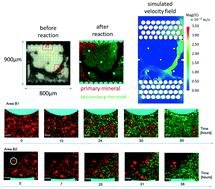Our official English website, www.x-mol.net, welcomes your
feedback! (Note: you will need to create a separate account there.)
Microfluidic flow-through reactor and 3D Raman imaging for in situ assessment of mineral reactivity in porous and fractured porous media.
Lab on a Chip ( IF 6.1 ) Pub Date : 2020-06-15 , DOI: 10.1039/d0lc00360c Jenna Poonoosamy 1 , Cyprien Soulaine , Alina Burmeister , Guido Deissmann , Dirk Bosbach , Sophie Roman
Lab on a Chip ( IF 6.1 ) Pub Date : 2020-06-15 , DOI: 10.1039/d0lc00360c Jenna Poonoosamy 1 , Cyprien Soulaine , Alina Burmeister , Guido Deissmann , Dirk Bosbach , Sophie Roman
Affiliation

|
An in-depth understanding of dissolution and precipitation of minerals in porous and fractured porous media and the complex feedback on the transport of fluids is essential for various subsurface applications. In this context, we developed a novel non-destructive “lab-on-chip” approach for quantitative in situ assessments of mineralogical changes in porous media. Our experimental approach involves a microfluidic flow-through reactor of reactive homogeneous and heterogeneous (fractured) porous media coupled with high-resolution imaging. Here, the reactive medium consists of compacted celestine grains seeded in a reservoir within the microfluidic chip. This medium reacts with a barium chloride solution injected into the microreactor at a constant flow rate, leading to the dissolution of celestine and growth of barite. Various seeding processes of the mineral grains allow the creation of homogeneous reactive porous media or the introduction of large heterogeneities such as fractures. Hence, our approach enables high-resolution investigations of reactive transport in fractured porous media. The use of confocal Raman spectroscopic techniques enables the spatio-temporal visualization of the mineral transformation at the pore-scale in two- and three-dimensions. Moreover, advanced pore-scale modelling correlates the hydrological heterogeneities to the geochemical observations in the micro-reactor, which explains the observed discrepancies between homogeneous and heterogeneous reactive media. Eventually, the proposed methodology can be applied to other chemical systems to provide new insights into hydro-geochemical coupling in porous and fractured porous media as well as high-fidelity datasets to benchmark reactive transport codes that are currently under development.
中文翻译:

微流过反应器和3D拉曼成像技术,用于原位评估多孔和压裂多孔介质中的矿物反应性。
对于各种地下应用而言,深入理解矿物在多孔和压裂多孔介质中的溶解和沉淀以及对流体传输的复杂反馈至关重要。在这种情况下,我们开发了一种新颖的非破坏性“芯片实验室”方法,用于原位定量分析多孔介质中矿物学变化的评估。我们的实验方法涉及反应性均质和非均质(破裂)多孔介质与高分辨率成像相结合的微流过反应器。在这里,反应介质由压实的天青石颗粒组成,这些颗粒被注入微流控芯片内的储层中。该介质与以恒定流速注入微反应器的氯化钡溶液反应,导致天青素溶解和重晶石生长。矿物颗粒的各种播种过程允许创建均质的反应性多孔介质或引入大的异质性,例如裂缝。因此,我们的方法能够对裂隙多孔介质中的反应运移进行高分辨率研究。共焦拉曼光谱技术的使用使得能够在二维和三维的孔尺度上可视化矿物转化的时空可视化。此外,先进的孔隙尺度模型将水力非均质性与微反应器中的地球化学观测值相关联,这解释了所观测到的均质和非均质反应介质之间的差异。最终,所提出的方法可以应用于其他化学系统,以提供有关多孔和压裂多孔介质中水文地球化学耦合以及高保真度数据集的新见解,以基准化目前正在开发的反应性运输代码。先进的孔尺度模型将水力非均质性与微反应器中的地球化学观测值相关联,这解释了所观测到的均质和非均质反应介质之间的差异。最终,所提出的方法可以应用于其他化学系统,以提供有关多孔和压裂多孔介质中水文地球化学耦合以及高保真度数据集的新见解,以基准化目前正在开发的反应性运输代码。先进的孔尺度模型将水力非均质性与微反应器中的地球化学观测值相关联,这解释了所观测到的均质和非均质反应介质之间的差异。最终,所提出的方法可以应用于其他化学系统,以提供有关多孔和压裂多孔介质中水文地球化学耦合以及高保真度数据集的新见解,以基准化目前正在开发的反应性运输代码。
更新日期:2020-07-14
中文翻译:

微流过反应器和3D拉曼成像技术,用于原位评估多孔和压裂多孔介质中的矿物反应性。
对于各种地下应用而言,深入理解矿物在多孔和压裂多孔介质中的溶解和沉淀以及对流体传输的复杂反馈至关重要。在这种情况下,我们开发了一种新颖的非破坏性“芯片实验室”方法,用于原位定量分析多孔介质中矿物学变化的评估。我们的实验方法涉及反应性均质和非均质(破裂)多孔介质与高分辨率成像相结合的微流过反应器。在这里,反应介质由压实的天青石颗粒组成,这些颗粒被注入微流控芯片内的储层中。该介质与以恒定流速注入微反应器的氯化钡溶液反应,导致天青素溶解和重晶石生长。矿物颗粒的各种播种过程允许创建均质的反应性多孔介质或引入大的异质性,例如裂缝。因此,我们的方法能够对裂隙多孔介质中的反应运移进行高分辨率研究。共焦拉曼光谱技术的使用使得能够在二维和三维的孔尺度上可视化矿物转化的时空可视化。此外,先进的孔隙尺度模型将水力非均质性与微反应器中的地球化学观测值相关联,这解释了所观测到的均质和非均质反应介质之间的差异。最终,所提出的方法可以应用于其他化学系统,以提供有关多孔和压裂多孔介质中水文地球化学耦合以及高保真度数据集的新见解,以基准化目前正在开发的反应性运输代码。先进的孔尺度模型将水力非均质性与微反应器中的地球化学观测值相关联,这解释了所观测到的均质和非均质反应介质之间的差异。最终,所提出的方法可以应用于其他化学系统,以提供有关多孔和压裂多孔介质中水文地球化学耦合以及高保真度数据集的新见解,以基准化目前正在开发的反应性运输代码。先进的孔尺度模型将水力非均质性与微反应器中的地球化学观测值相关联,这解释了所观测到的均质和非均质反应介质之间的差异。最终,所提出的方法可以应用于其他化学系统,以提供有关多孔和压裂多孔介质中水文地球化学耦合以及高保真度数据集的新见解,以基准化目前正在开发的反应性运输代码。











































 京公网安备 11010802027423号
京公网安备 11010802027423号